|
|

Developed By
Scott L. Crouse, PhD
Copyright © 2017 LDinfo Publishing
Jump to:
Section 1 - Overview of the FBA Screener
Section 2 -
Section 3 - Statistical Properties of the FBA Screener
Section 4 - Interpretation of the FBA Screener
Section 5 - Installation and Use of the FBA Profiler Screener software
Section 1
Overview of the FBA Profiler
Purpose/intent of the FBA Screener/FBA Profiler:
Emotional and behavioral needs of children and adolescents have been evaluated for decades through the use of various behavior rating scales or profiles. These rating scales typically have been used to compare an individual student’s observable behavior with that of the “normal” or general student population in order to determine the significance of any behavioral differences found. The Individuals with Disabilities Education Act (IDEA) which was amended in 1995 and reauthorized in 2004, defines and clarifies a need for public schools to go beyond the mere identification of significant behavioral difficulties and to also perform a formal functional behavioral assessment (FBA). Clearly the intent of an FBA is to promote a more thoughtful and meaningful understanding of the underlying emotional needs or motivations which are served by the behavior so that appropriate and positive behavioral interventions can be developed to more directly meet the needs of individual students. Although various behavior rating scales have been developed and utilized for many years to identify significant behavioral difficulties in students and provide screening for certain mental health conditions (typically ADHD, conduct disorders, anxiety disorders, and/or depression) these rating scales typically do not address underlying emotional or psychological “needs” related to potential “functions” of behavior(s). Traditional behavior rating scales also frequently take a rather clinical approach to emotional/behavioral needs which is sometimes difficult for educators and/or parents to fully understand or utilize.
In contrast to traditional behavior rating scales, the FBA Profiler/Screener is specifically designed to not only identify specific areas of behavioral difficulty (i.e. “target behaviors”) but also to evaluate patterns of responses in order to identify potential underlying “functions” of the behavior(s) and promote more appropriate and effective behavioral intervention. The FBA Profiler (but not Screener) also provides a broad-spectrum mental health screening in nine specific categories (based largely upon current DSM criteria). Most importantly, the FBA Profiler/Screener has been designed by a practicing school psychologist to be directly relevant to the psychoeducational needs of children and adolescents, with interpretations and suggested interventions which are easily understood by teachers and parents. The FBA Profiler/Screener is also normed for ages 3 through adult for use before and beyond the typical school-aged population.
Unique Design of the FBA Screener Professional software package:
Unlike other behavior rating scales which require an examiner to separately purchase rating forms, examiner/technical manual, and computer scoring software, the FBA Screener is provided entirely as a computer software package compatible with both Windows (PC) and Macintosh computer operating systems. The software package includes the FBA Screener teacher rating forms, an application for entry and scoring of the rating forms, (resulting in extensive computer-generated reports), online instructions, and web-based links to the examiner/technical manual as well as other relevant or updated information. The entire software package is provided to individual users, small groups, or larger “sites” through a registration process which provides users unlimited access to rating forms and scoring/reporting options throughout the duration of the registration period (1 to 3 years). Users are also entitled to any available software updates throughout their registration period at no additional cost.
Development of the FBA Screener:
Standardization-
Normative data for the FBA screener has been derived from data previously gathered to establish the norms for the FBA Profiler. This data has been collected since 2005 and is regularly updated from sample data provided by cooperating school districts throughout the United States. These districts have been taking part in this ongoing standardization process by gathering and submitting rating data from a broad random sampling of subjects from the general population.
Age and Gender: For the current 2017 edition, the chosen standardization sample of 5804 subjects was separated into twelve age/gender groups which were used in the development of the formal FBA Screener norms. Table 1.1 shows the total number of subjects in each group.
Table 1.1
Standardization Samples by Age and Gender
| Age Group | Male (N) | Female (N) |
|---|---|---|
3-0 to 6-11 |
762 |
476 |
7-0 to 10-11 |
835 |
596 |
11-0 to 14-11 |
414 |
366 |
15-0 to 18-11 |
174 |
275 |
19-0 to 22-11 |
223 |
822 |
23-0 + |
196 |
665 |
Ethnicity: Ethnic distribution within the FBA Screener standardization group has been adjusted to match current U.S. census data.
Because of concern regarding nonbiased assessment practices, additional data analysis was conducted to determine the significance of any potential differences found between ratings of "white" and "non-white" individuals. Two-tailed t-tests were performed comparing white and non-white average raw scores obtained in each target behavior category. These statistical comparisons found no significant differences across any of the eight target behavior categories as a function of ethnicity. This suggests that the FBA Screener is able to provide a non-biased screening of behavioral difficulties across racial groups.
Appropriate use of the FBA Screener:
The FBA Screener is intended to provide an efficient means of rating large groups of students in order to identify those at highest risk of exhibiting emotional and/or behavioral difficulties. It also can help to provide initial hypotheses regarding the underlying functions of these difficulties to facilitate the development of appropriate classroom interventions. The FBA Screener also provides a convenient means of tracking and plotting progress over time.
The FBA Screener consists of a one-page checklist (see Appendix A) which can be completed by teachers or other group leaders. These forms consist of approximately 8 descriptive/identifying items followed by 30 rating items. Each item is rated on a scale of 1 to 3 with 1 indicating that the item is not at all true (or not observed), 2 indicating that the item is somewhat true, and 3 indicating that the item is very true for the subject being rated.
Raters should be instructed to use a rating of "1" when the behavior either is not observed or when uncertain about the correct response.
Brief description of the rating scales:
Target Behaviors – What specific types of behavior are being observed? The following specific areas are evaluated according to age-based national norms to determine statistical significance of any behaviors observed.
Internalizing Externalizing
Task Avoidance Disruption
Social Withdrawal Delinquency
Passive Aggression Active Aggression
Somatic Issues Defiance
Hypothesized Functions of Behavior – What are likely underlying emotional motivations for observed behaviors? The following specific areas are evaluated according to an empirically-based criterion reference in order to establish a pattern of “relatively significant concern”.
Attention-Seeking
Social Status
Escape/Avoidance
Anxiety-Reduction
Self-Indulgence
Defensive Reaction
Power/Control
Revenge
Section 2
The FBA Screener Rating Scales
Following are detailed descriptions of the various behavioral and functional categories evaluated by the FBA Screener.
The Target Behavior Scale:
Target behaviors are specific and observable areas of behavioral concern which can be identified for possible intervention. Ratings provided within this category include:
Task Avoidance/Off-Task – A relatively significant rating in this area suggests a tendency to avoid, ignore, or otherwise fail to accomplish required or expected tasks including homework, daily chores, etc.
Social Withdrawal - A relatively significant rating in this area suggests a tendency to be somewhat socially isolated and avoid situations in which social interaction is expected or required.
Passive Aggression - A relatively significant rating in this area suggests a tendency to attempt to assert control or 'get back at others' through indirect means such as tattling, writing threatening notes, spreading rumors, defacing property, etc.
Somatic Issues - A relatively significant rating in this area suggests a tendency to complain of physical symptoms or 'ailments' such as headaches, nausea, body aches, minor injuries, etc.
Disruption - A relatively significant rating in this area suggests a tendency to engage in behavior which disturbs, interrupts, or draws others 'off-task'.
Delinquency - A relatively significant rating in this area suggests a tendency to engage in negative or rebellious behavior with peers.
Active Aggression - A relatively significant rating in this area suggests a tendency to become angry and start physical fights or verbal arguments with others.
Defiance - A relatively significant rating in this area suggests a tendency to deliberately break rules or otherwise challenge and/or defy authority.
The Functions of Behavior Scale:
Hypothesized functions of behavior are assumed underlying emotional needs or motivations which may result in certain predictable behavioral tendencies. Ratings within this category include:
Attention Seeking – A relatively significant rating in this area suggests that the subject's behavior may allow him to gain attention from others. Typical behaviors may include teasing, complaining, interrupting, or otherwise disrupting those around him. Suggested interventions include:
- Provide appropriate opportunities to gain positive attention from others.
- Assign 'important' jobs around the house or classroom.
- Give opportunities for him to help others with tasks or assignments.
- Provide extra praise and/or encouragement.
Social Status - A relatively significant rating in this area suggests that the subject's behavior may be intended to gain social acceptance or status and to 'save face' or avoid embarrassment among his peers. Typical behaviors may range from withdrawal or avoidance (to evade potentially embarrassing situations) to aggression or defiance (to impress or 'fit in with' certain peers). Suggested interventions include:
- Promote positive social connections (i.e. paired or team projects, etc.).
- Avoid 'public' criticism, punishment, or embarrassment.
- Provide a 'safe way out' of a difficult or embarrassing situation.
- Help him to understand how his behavior may alienate others.
Escape/Avoidance - A relatively significant rating in this area suggests that the subject's behavior may enable him to escape or avoid an unpleasant, difficult, or potentially embarrassing situation. Typical behaviors of this nature include general fear-of-failure reactions such as task avoidance and social withdrawal but may also involve perfectionism. Suggested interventions include:
- Provide tangible reinforcement (rewards).
- Reward effort or participation rather than outcome.
- Avoid tasks which are clearly beyond his capabilities.
- Provide gentle prodding and encouragement.
Anxiety Reduction - A relatively significant rating in this area suggests that the subject's behavior may help him to relieve stress and/or anxiety. Such behavior is frequently obsessive and/or compulsive in nature and can be somewhat disruptive or annoying to those around him. Suggested interventions include:
- Provide acceptable outlets for stress (such as a soft toy or ball to squeeze).
- Allow frequent breaks or 'time-outs' when he chooses.
- Encourage him to share his feelings of anxiety with others.
- Avoid placing him in potentially stressful situations.
Self Indulgence - A relatively significant rating in this area suggests that the subject's behavior may allow him to do as he pleases with little regard for the needs or desires of others. This can cause friction and relationship difficulties with both peers and adults. Typical behaviors such as task avoidance, delinquency, and defiance may occur when he is asked to do something which he finds difficult or unpleasant. Suggested interventions include:
- Offer several acceptable choices rather than a single demand or expectation.
- Help him to find the relevance in a given task or assignment (i.e. why should this matter to ?).
- Develop a behavioral contract with mutually identified expectations, consequences, and rewards.
- Help him to understand how behavior impacts others.
Defensive Reaction - A relatively significant rating in this area suggests that the subject's behavior may be related to a need to defend himself from a perceived threat, challenge, or rejection which may or may not have been intended. Typical behaviors of this nature include verbal or physical aggression and/or abrupt social withdrawal. This behavior can be the result of a somewhat paranoid perception of social situations and is often viewed by others as an unexpected overreaction to harmless teasing, meaningless comments, etc. Suggested interventions include:
- Help him to more accurately perceive social situations.
- Help him to feel safe, accepted, and supported.
- Intervene quickly when it appears he may feel criticized or potentially embarrassed.
- Temper any potentially critical remarks in order to avoid a possible overreaction.
Power/Control - A relatively significant rating in this area suggests that the subject's behavior may be intended to challenge authority and/or assert control over his own life or those around him. This can be related to feelings that others have been overly controlling or unfairly punitive. Typical behaviors may include task avoidance, delinquency, aggression, and/or defiance. Suggested interventions include:
- Choose your battles carefully - don't engage in power struggles over insignificant issues.
- Don't back down on important issues.
- Respect his need to make many of his own choices.
- Allow him to experience the “natural consequences” of his choices and learn from his mistakes.
Revenge - A relatively significant rating in this area suggests that the subject's behavior may be intended to 'get back at' or put others 'in their place'. This can be related to feelings that others have been mean or unfair to him. Typical behaviors may include passive aggression, active aggression, or defiance. Suggested interventions include:
- Provide frequent and appropriate opportunities to vent anger or frustration.
- Mediate quickly to resolve conflicts (don't let problems fester).
- Encourage open communication so that he feels heard and understood.
- Provide support when he is feeling “victimized”.
Section 3
Statistical Properties of the FBA Screener
Scores provided by the various scales of the FBA Screener:
Target Behaviors
The norm-referenced t-scores provided within the FBA Screener target behavior category are based upon a normative sample of over 5800 individuals ages 3 through 60, across the United States.
T-scores in each “target behavior” area or within the overall “internalizing” or “externalizing” composites reflect a comparison between a particular subject's rating and the population "norm" for that rating group based upon the subject’s age and gender. The mean is set at 50 and the standard deviation set at 10 in order to facilitate interpretation similar to most other behavior rating scales. These standard scores can be plotted on a computer generated report to provide a visual display of relatively significant behavioral concern. T-scores below 60 are considered to fall within the average or “normal” range. T-scores between 60 and 70 are considered “at risk” and suggest “moderate” behavioral concern. T-scores of 70 or above are considered “clinically significant” and suggest relatively severe behavioral concern.
Functions of Behavior
Ratings within the “function of behavior” category simply reflect relative levels of concern based upon average item ratings within each specific functional category. Average item scores greater than 1.8 and less than or equal to 2.2 are rated “at risk” and average scores greater than 2.2 are rated “clinically significant”.
Reliability of the FBA Profiler:
Internal Consistency - In order to assess the internal consistency and overall reliability of the FBA Screener a split-half method was employed in which the entire FBA Screener item pool and each subscale was randomly divided into 2 similar forms. These split-half correlations were then gathered from the entire normative sample of 5804 cases and are presented in Tables 3.1 (female) and 3.2 (male). Correlations across the entire item pool range from .90 to .96. This data verifies that the FBA Screener has very strong internal consistency.
Table 3.1
Split-Half Reliability Coefficients
All ages 4-7 7-11 11-15 15-19 19-23
Female .92 .96 .91 .91 .93 .93
Male .91 .92 .95 .93 .93 .95
Validity of the FBA Profiler:
Content Validity - The initial item selection and categorization for the FBA Screener (within the target behavior and functions of behavior categories) has been derived through an empirically-based process which utilized published research findings related to emotional/behavioral development along with hundreds of direct observations and interviews with parents and teachers of children and adolescents. The initial item groupings were then refined through an extensive process of factor analysis to ensure that each item was indeed loading on the specific emotional or behavioral factor being rated.
Construct Validity – Construct validity of the FBA Screener has been established through a direct comparison of internalizing and externalizing t-scores derived form the FBA Screener and FBA Profiler obtained from the same subjects within the normative sample. Table 3.3 provides correlational data obtained from those records which confirms strong construct validity for the FBA Screener. Note: construct validity of the FBA Profiler was previously established through correlational studies with other popular emotional/behavioral rating scales.
Table 3.3
Correlations between FBA Screener and FBA Profiler
Correlation
Task Avoidance .88
Social Withdrawal .89
Passive Aggression .95
Somatic Issues .94
Disruption .89
Delinquency .90
Active Aggression .95
Defiance .91
Total Internalized .93
Total Externalized .94
Overall, this reliability and validity data provide very strong support for the FBA Screener as a screening instrument for emotional and behavioral disorders.
Section 4
Interpretation of the FBA Screener
Once you have gained a basic understanding of the design and intent of the FBA Screener (see sections 1 and 2), interpretation is fairly obvious and straight-forward. After the FBA Screener ratings have been entered into the computer scoring program for a given group of students, a list of students within that group is provided which displays a “risk rating” for each student (low risk, moderate risk, and high risk). This listing can be sorted by student name or risk rating. Since a given group of students can be rated up to 6 separate times (to measure change over time) buttons are provided toward the top of the screen for viewing any given rating (1-6). A button is provided to the right of each listing to display the specific rating data for that individual student. This will provide a visual display of ratings in each category (target behaviors and functions of behavior) along with a computer-generated interpretive report along with a charting of overall internalized and externalized scores across rating periods (to see change over time). Back on the displayed list of all students, an overall summary of all screenings can obtained by clicking a button near the top of the screen entitled “View This Summary”. This will display only summary data for this particular group of students with charts depicting averaged internalizing and externalizing t-scores and the total number of students falling within each risk category across all available screenings. This will be explained further in section 5.
Target Behaviors (when viewing individual student data)
The target behavior scale is intended to proved a norm-referenced rating of observable behavior in order to statistically establish the significance of any identified behavioral concerns. T-scores in each “target behavior” area or within the overall “internalizing” or “externalizing” composites reflect how a particular subject's rating compares to the population "norm" for that rating group based upon the subject’s age and gender. The mean is set at 50 and the standard deviation set at 10 in order to facilitate interpretation similar to most other behavior rating scales. These standard scores are plotted on the FBA Screener computer generated chart to provide a visual display of relatively significant behavioral concern. T-scores below 60 are considered to fall within the average or “normal” range. T-scores between 60 and 70 are considered “at risk” and suggest “moderate” behavioral concern (reflecting behavior observed within approximately 15% of the normal population). T-scores of 70 or above are considered “clinically significant” and suggest relatively severe behavioral concern (reflecting behavior observed within less than 2% of the normal population).
Functions of Behavior (when viewing individual student data)
Ratings within the “function of behavior” category simply reflect relative levels of concern based upon patterns of observed behavior found within specific ratings. Identified “functions” of concern reflect underlying emotional motivations for certain types of behavioral difficulty and may not always reflect current behavior problems. In other words, if relatively significant concern in noted in certain “functional” areas but not within the “target behavior” category, this may suggest areas of vulnerability or emerging concern, possibly suggesting ongoing monitoring or even preemptive support or intervention.
Section 5
Installation and Use of the FBA Screening Software
Installation:
The FBA Screener software is now included as part of the consolidated LDinfo software package (consisting of the Cognitive Processing Inventory – CPI, FBA Profiler, and FBA Screener). If the LDinfo software package was downloaded from the LDinfo web site, your web browser probably un-stuffed the file and created the appropriate LDinfo installer (for Macintosh or Windows) on your hard drive. Whether installing from the downloaded installer or from the CD-ROM, simply open the installer and follow the on-screen instructions.
Using the FBA Screener:
To begin using any of the LDinfo Apps (CPI Pro, FBA Pro or FBA Screener) simply double-click the LDinfo Apps icon on the Windows desktop (or from the Program Files" directory) or on the Macintosh dock.


The opening window will display your registration status. The first time you open the app your status will be "demo" because you have not yet entered a registration code. The demo version includes the complete software package but is somewhat limited when it comes to printing rating forms or reports.
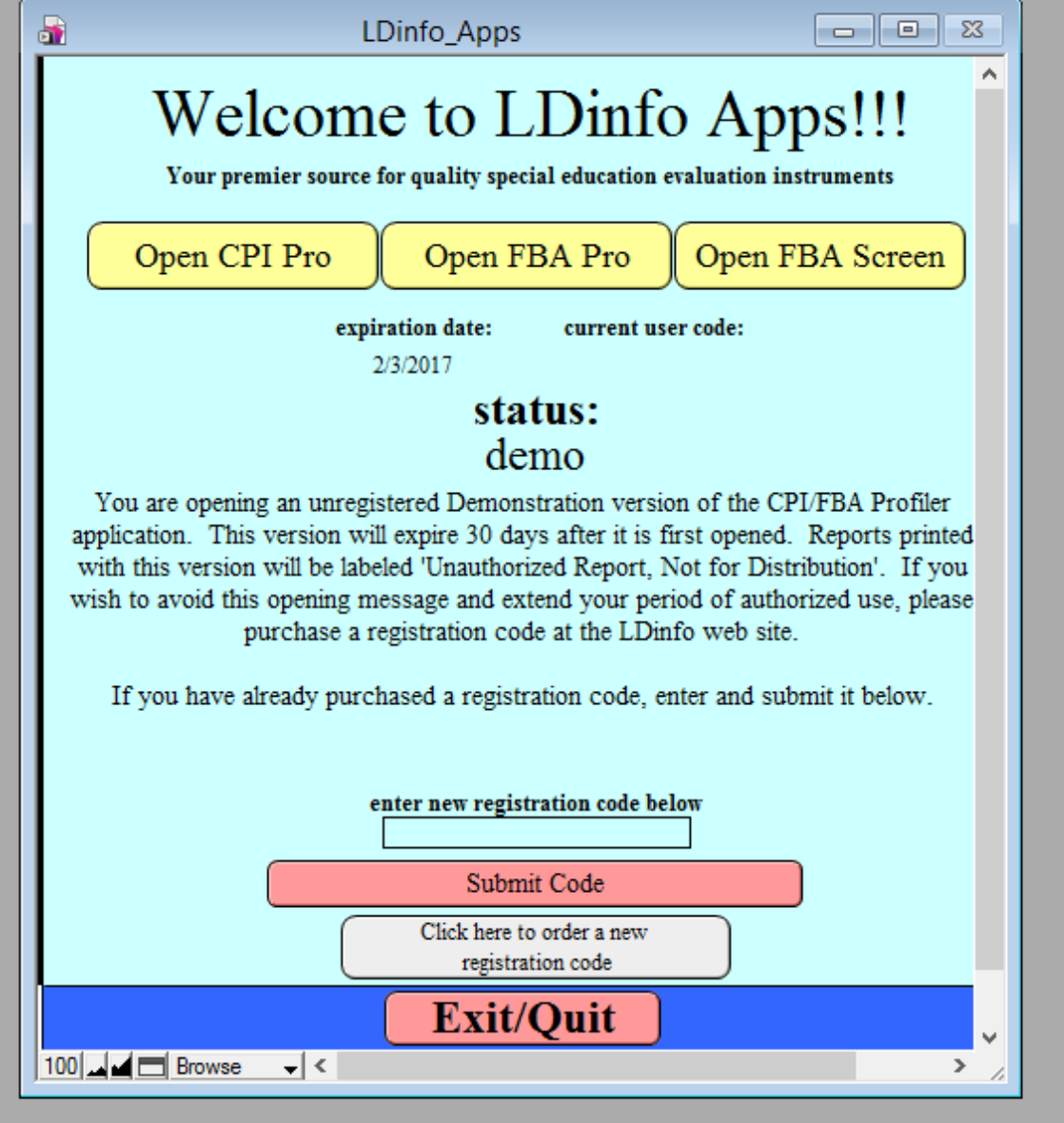
If you have purchased a registration code, simply enter and submit that code toward the bottom of the screen.
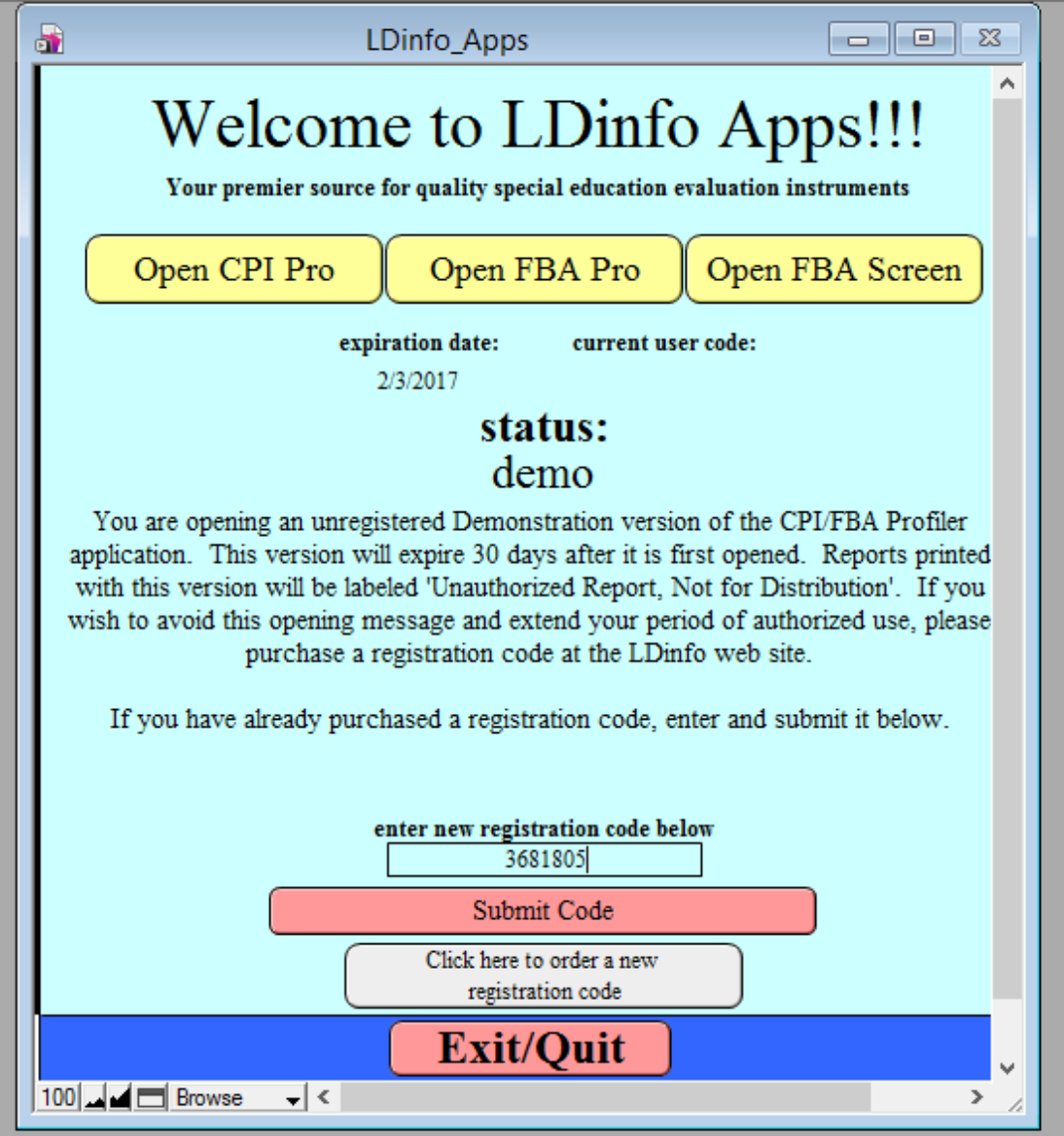
You will then be presented with a thank you message to let you know that the registration process has been successful.
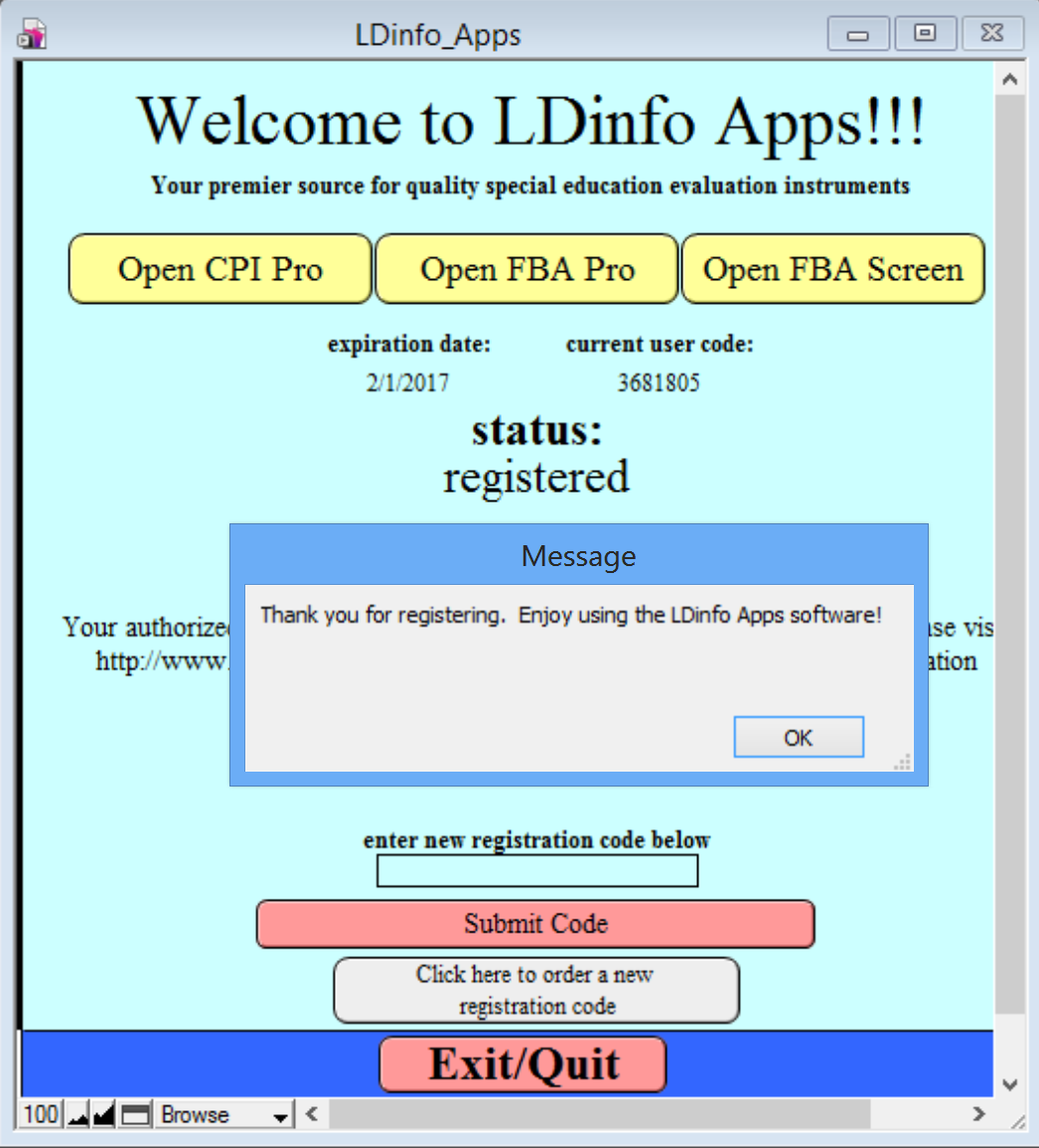
Simply click “OK” on that message and
the software will reopen to complete the registration process.
At this point you may begin using any of the LDinfo Apps by simply clicking the appropriate button toward the top of the screen.
NOTE: Reports cannot be printed during the free trial period or after your registration period has expired.
Completing entries for a new
group of subjects is accomplished in 4 easy steps as follows:
Step 1: From the opening screen
click the button entitled 'View/Print FBA Profiler Rating Forms'. A new window
will open in which you can preview and/or print the various paper rating forms.
You may either print 1 copy of each form and then duplicate them as needed or
just print new forms as you need them. In either case, the printed forms will
note the expiration date for you to legally print or duplicate the forms (based
upon your registration status).
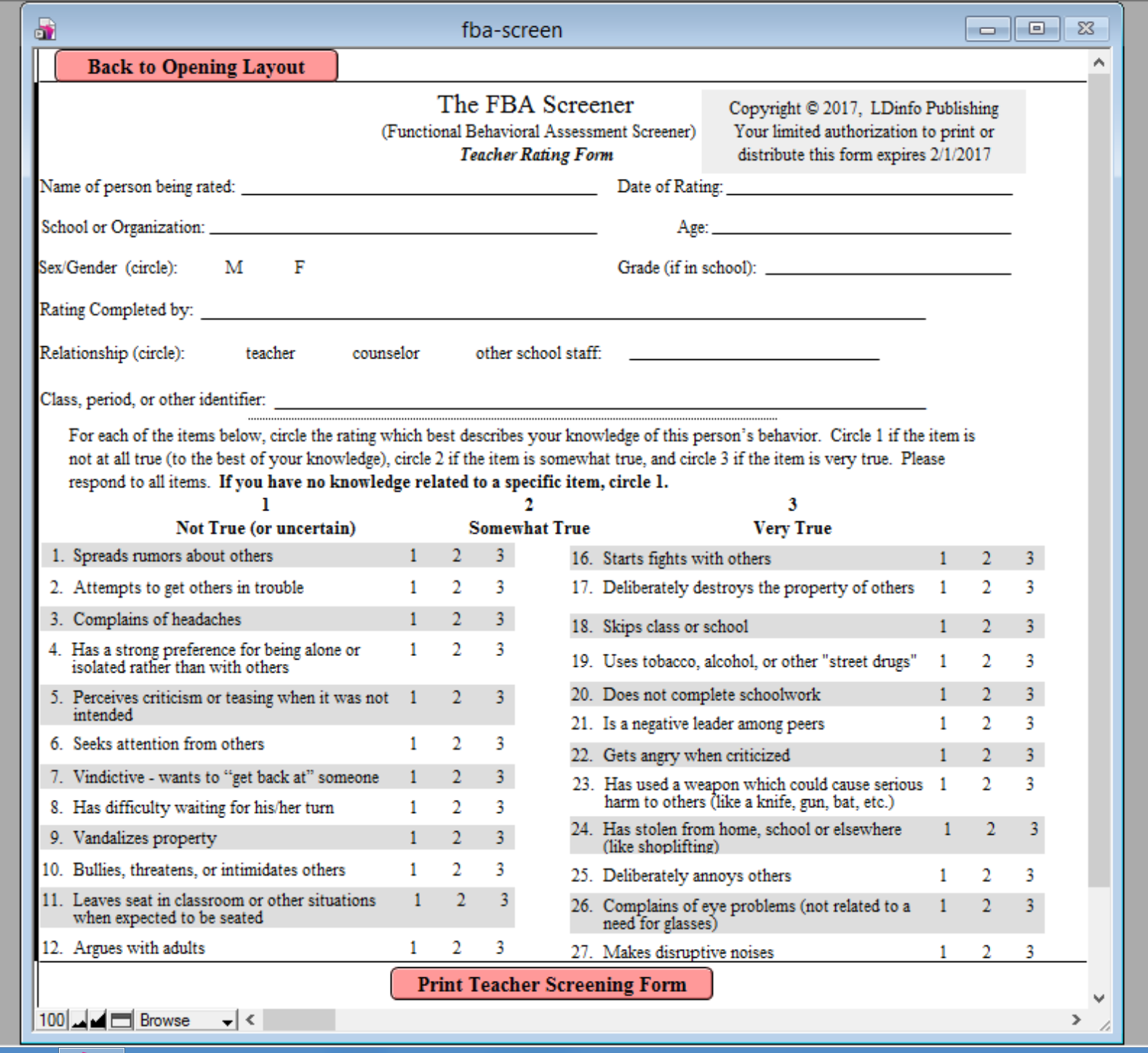
Step 2: Distribute FBA Screening
forms to teachers and collect the completed forms for
scoring.
Step 3: To score completed FBA Screener
forms, simply open the FBA Screener application and click the 'New Class Screening Entry'
button.
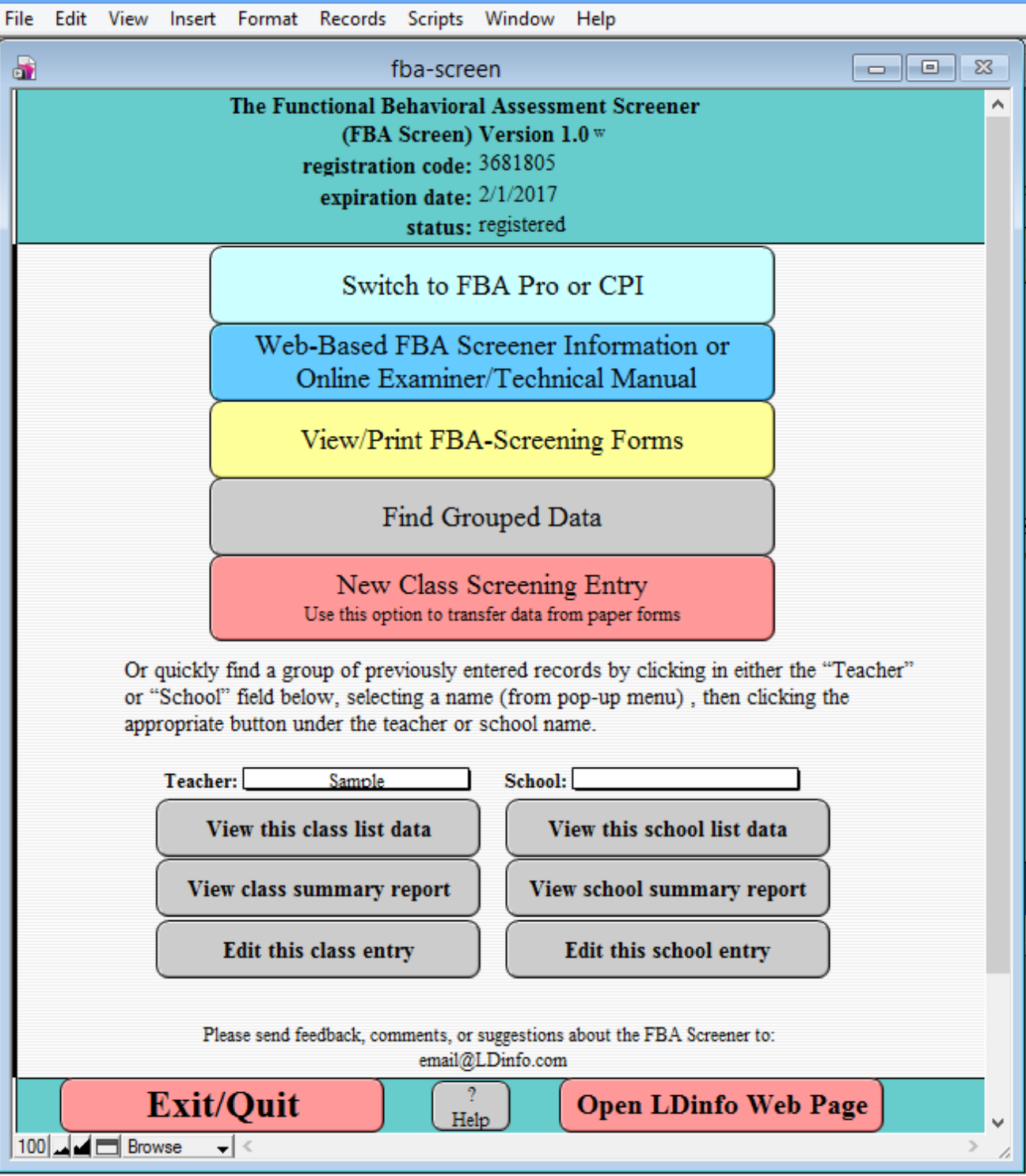
A new window will open which
allows entry of subject information including name, age, grade, school, etc. Be
sure to enter an age in whole years (no dashes, decimal points, months, etc.)
and sex so that the norm-referenced scores can be accurately calculated. Also provide sufficient information regarding school, teacher, grade, etc. to facilitate finding, editing, and creating reports for this particular group of students.
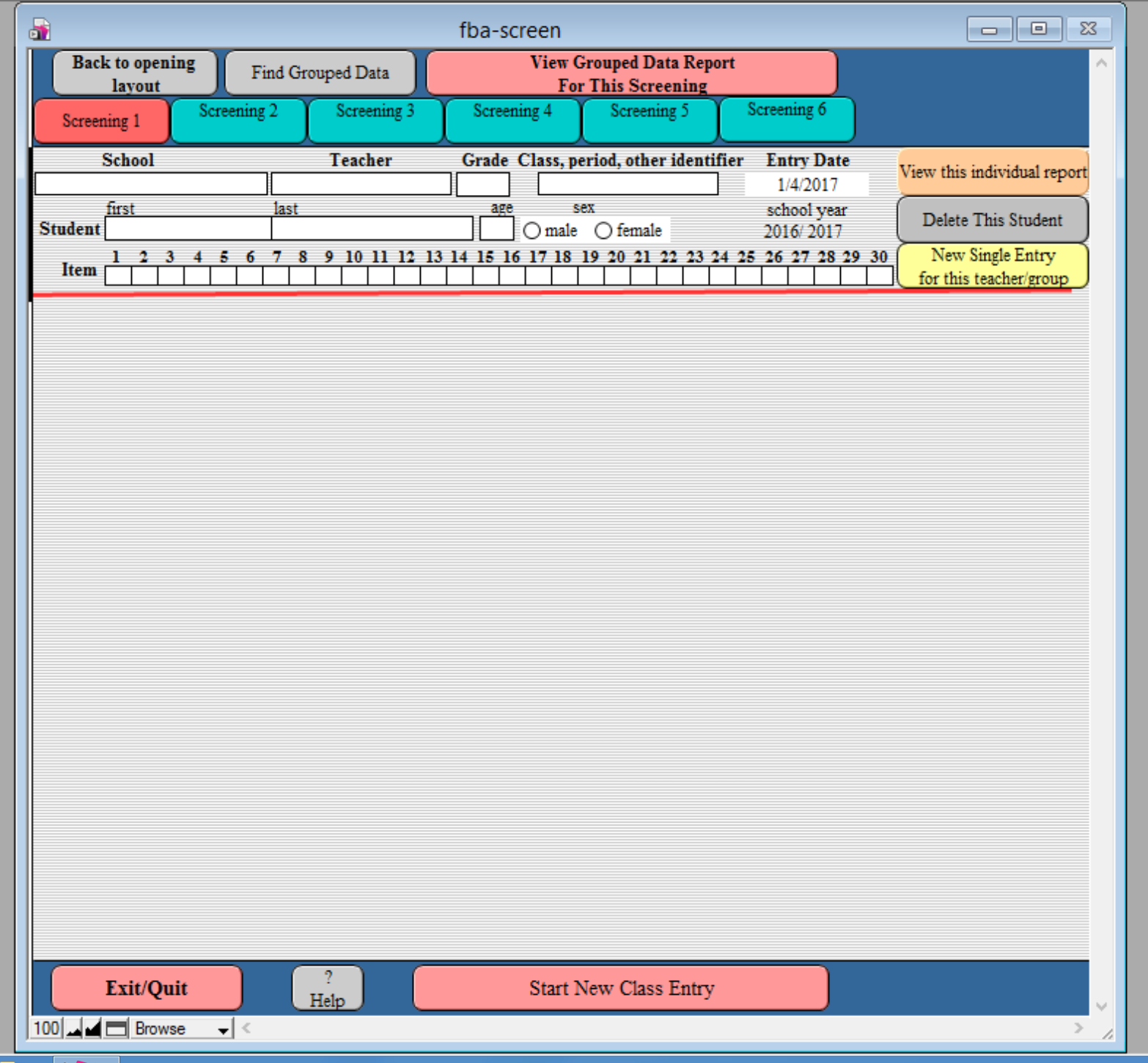
After the first student record has been entered, simply click the "New single entry" button to the right to enter the next student.
To enter subsequent rating data (to track progress over time), click the desired screening button toward the top.
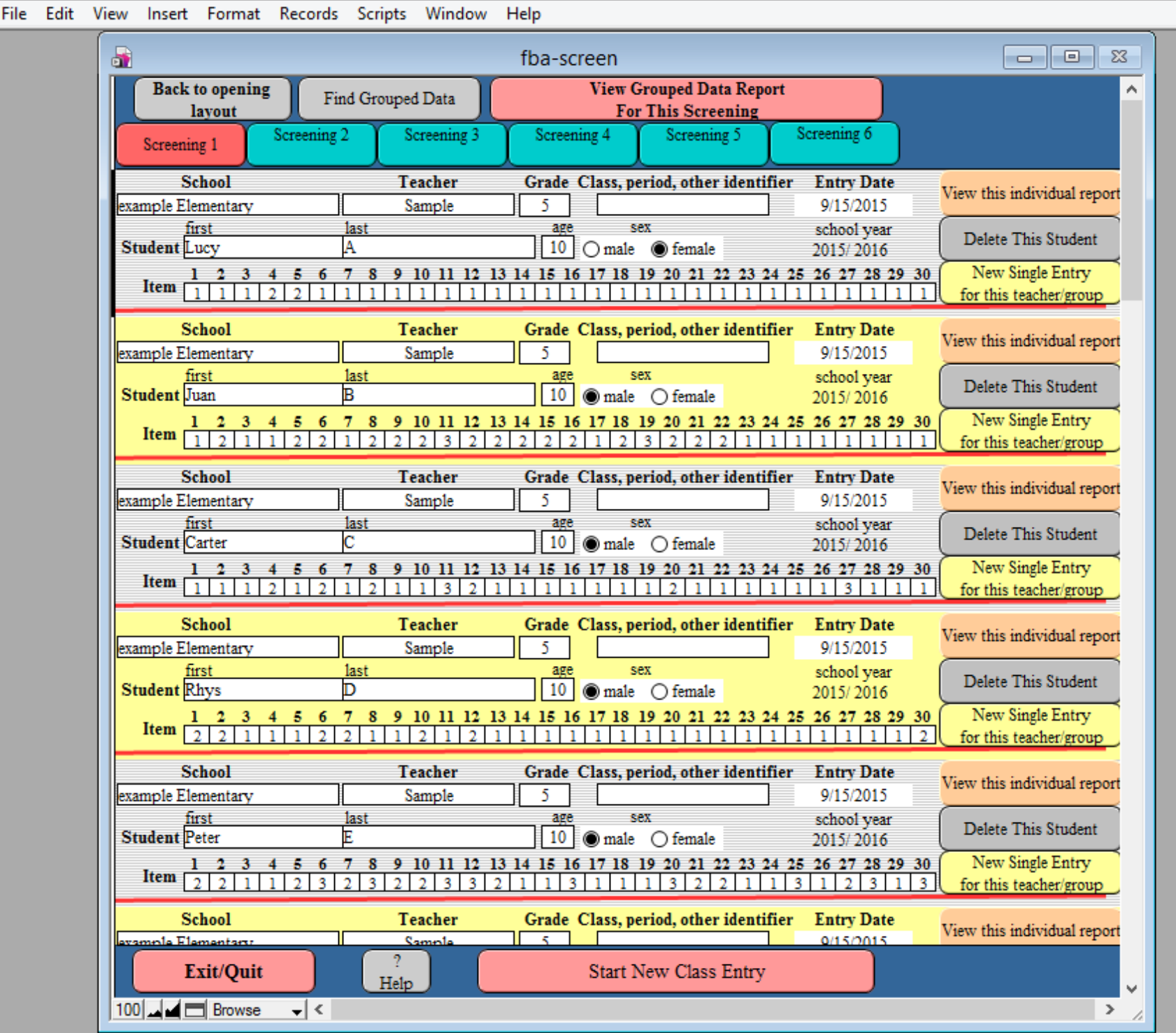
When all student data has been entered, click the "View Grouped Data Report" button at the top to view the overall findings for this group.
Use buttons toward the top of screen to sort the list as desired or view subsequent screenings.
Use "Print" button at the bottom to print this list report.
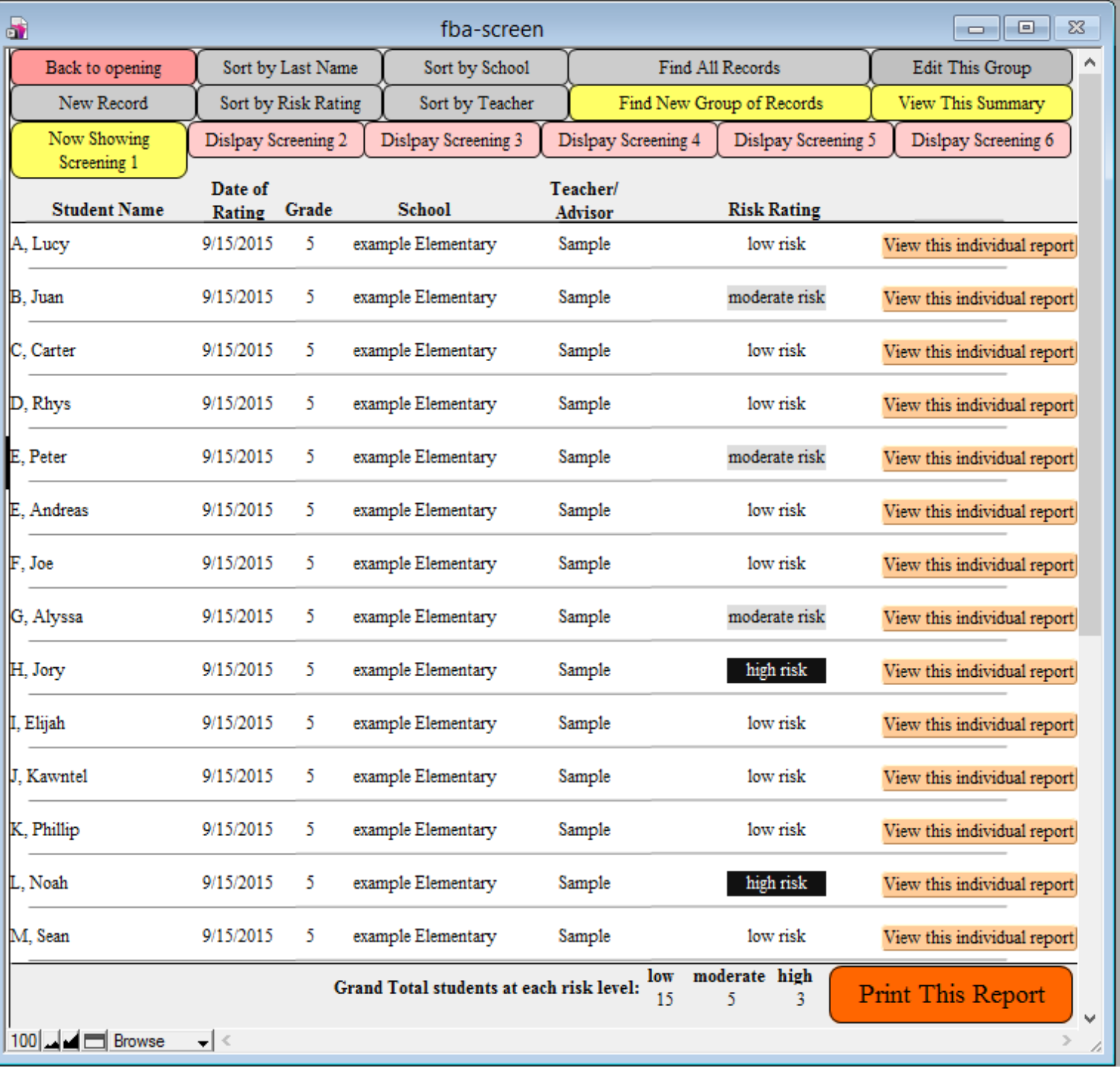
To view an individual student report, click the "View this individual report" button to the right of the student.
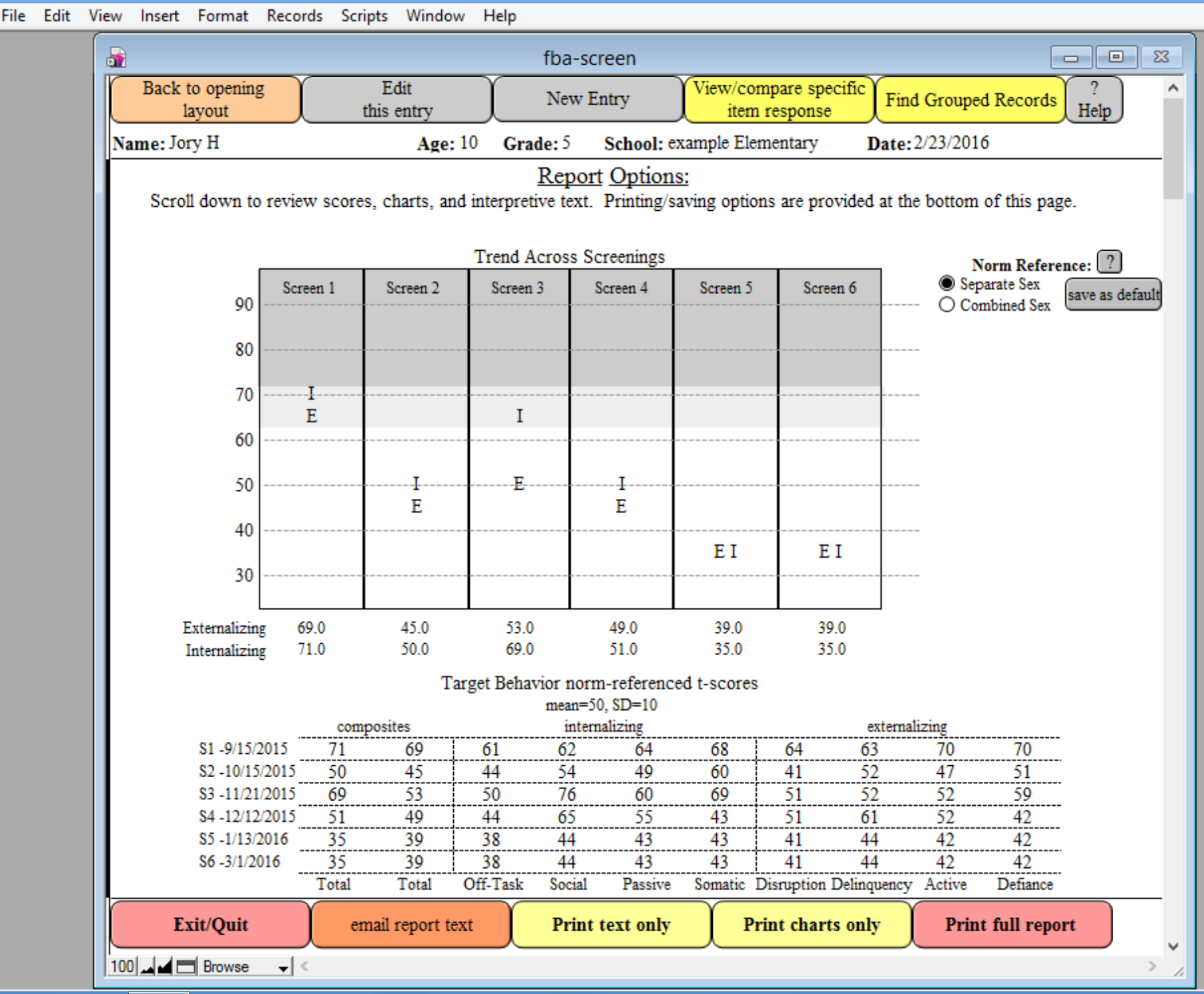
This report can be viewed in its entirety (including full text description of ratings and suggested interventions) or printed using the "Print" button at the bottom.
Use the "Find Grouped Records" button at the top to get back to this or another list of records.
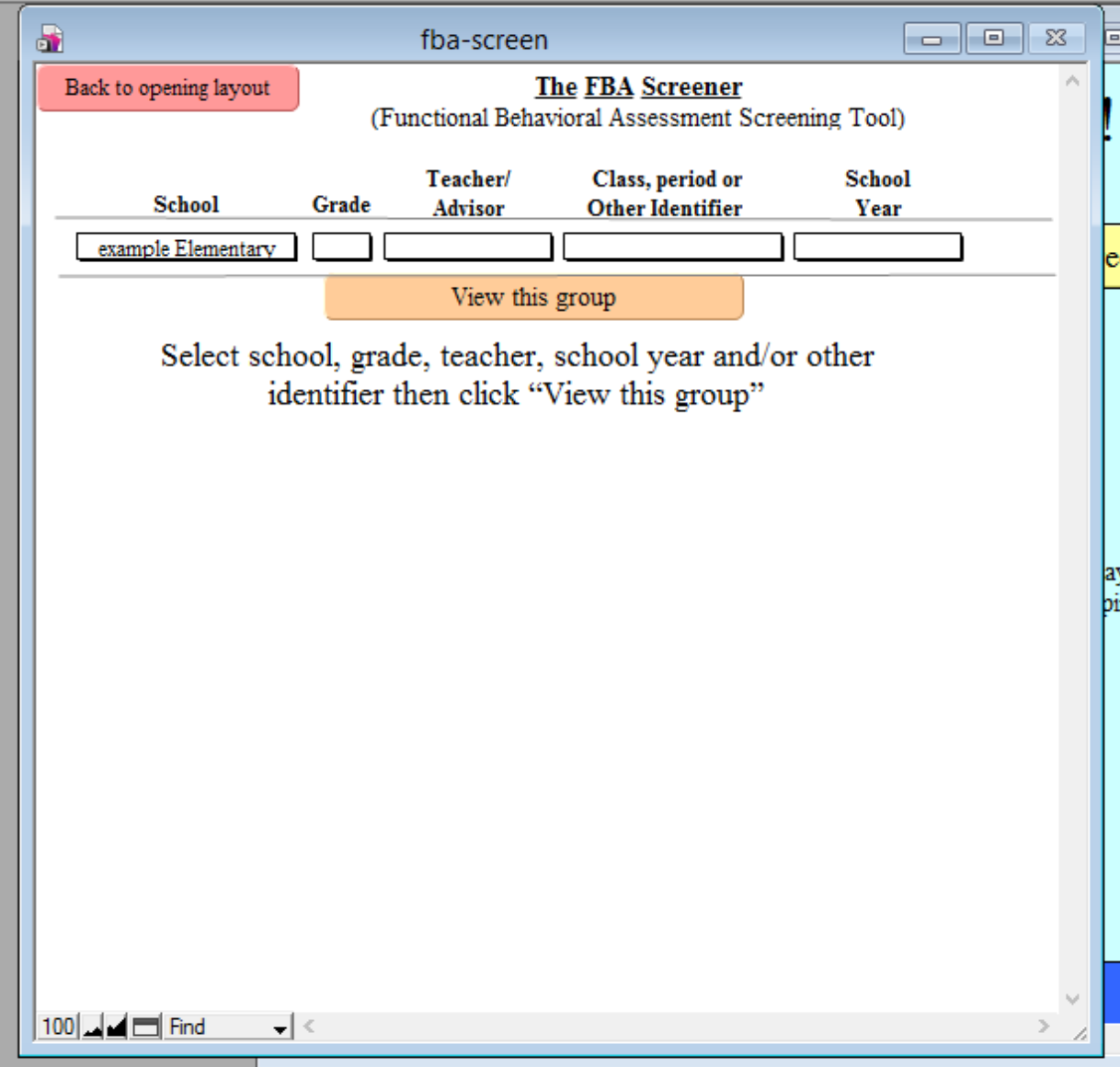

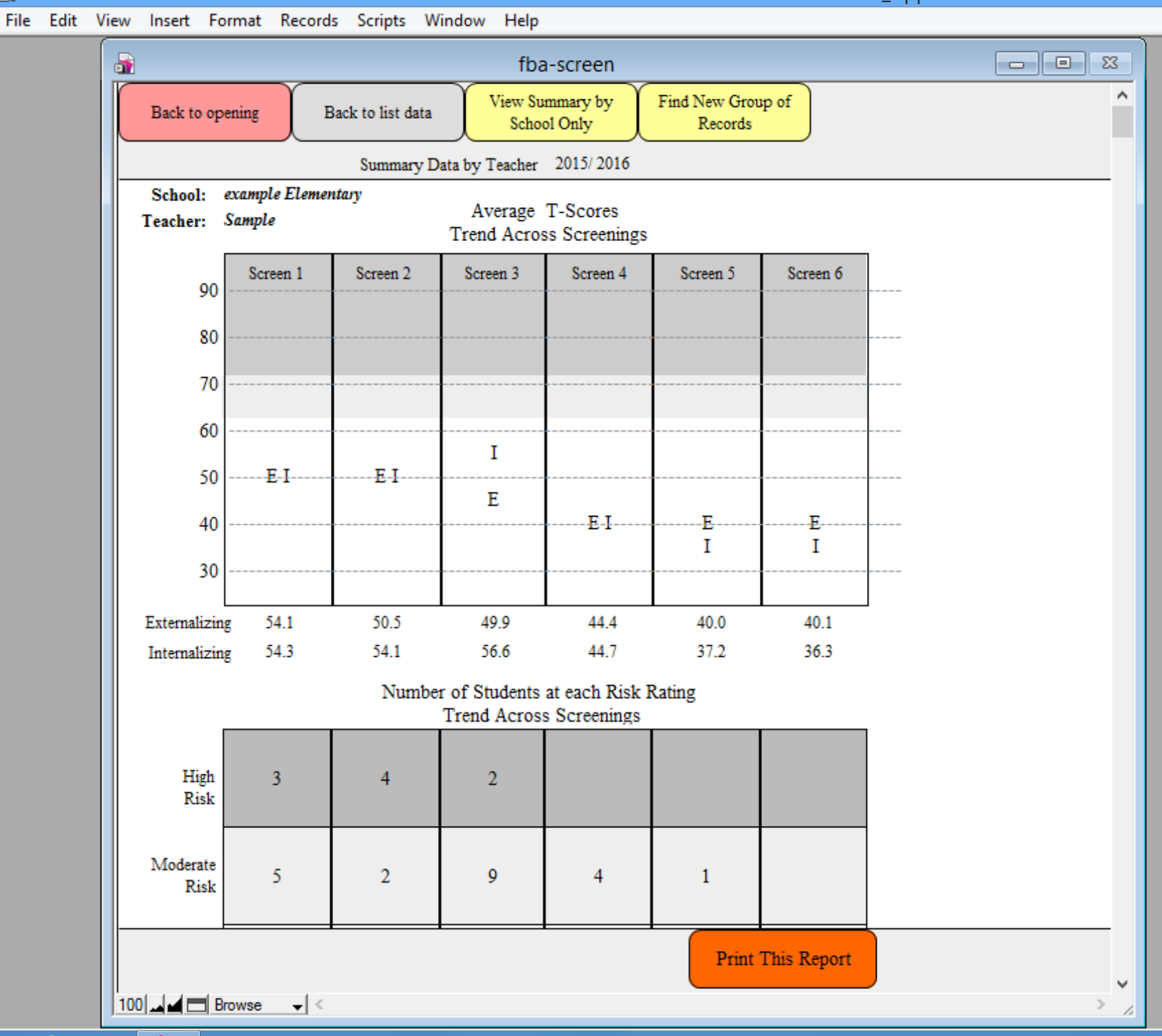
Saving Reports:
Data within the database is automatically saved whenever new data is entered.
Printing/distributing Reports:
Print buttons are included at the bottom of any screen which contains printable data. When printing an individual student report, the defalt print setting should be "Current record" as shown below:
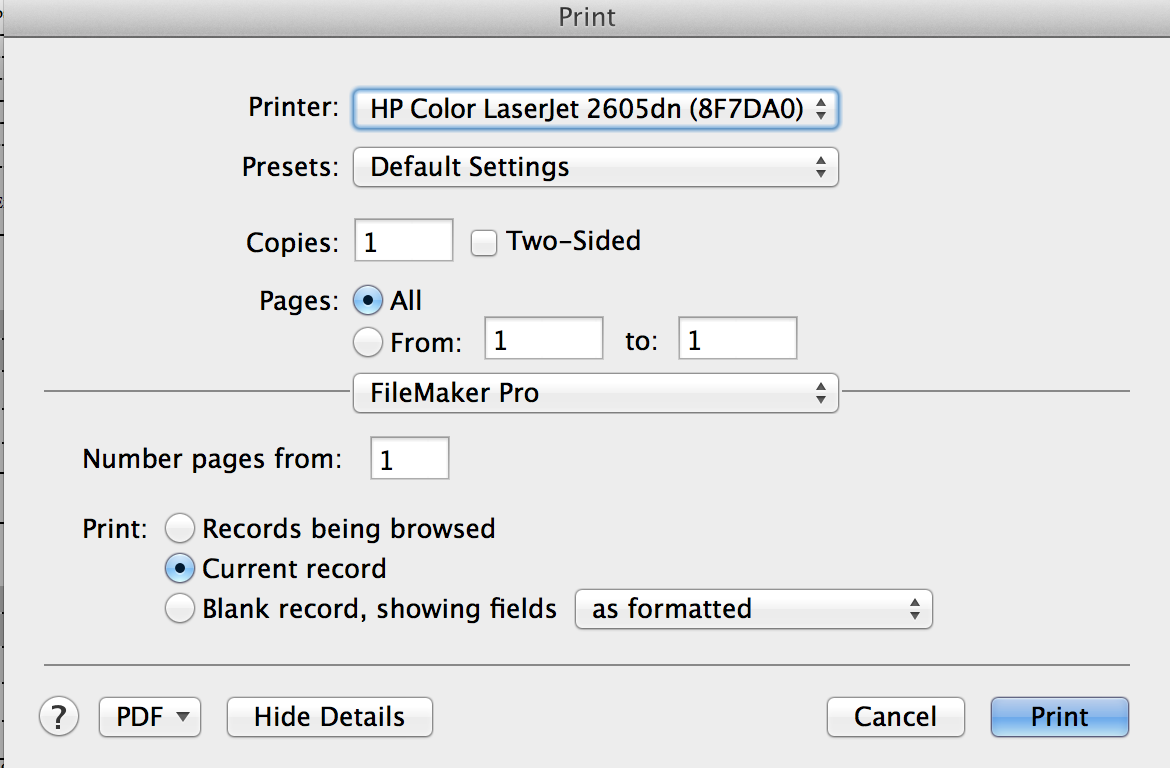
When printing a group summary report, the defalt print setting should be "Records being browsed" as shown below:
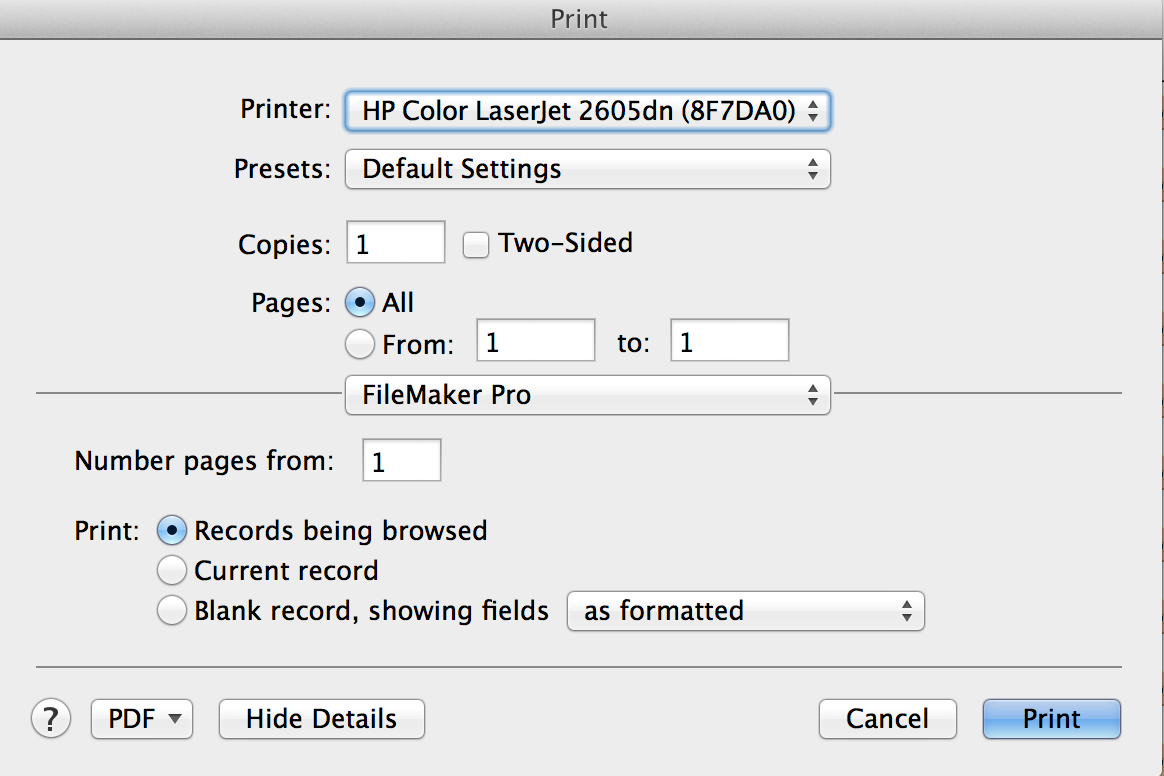
Besides printing full reports, you may also email the report text.
Sending report text via email is
accomplished by simply clicking the “Send as Email” button at the bottom of the
individual student report screen or selecting the appropriate option from the “Scripts” menu. This option only works if your computer
is set up with a default email application.
In the screen which opens, simply enter a valid email address and edit the subject and message body as desired before clicking the “Send Mail” button.
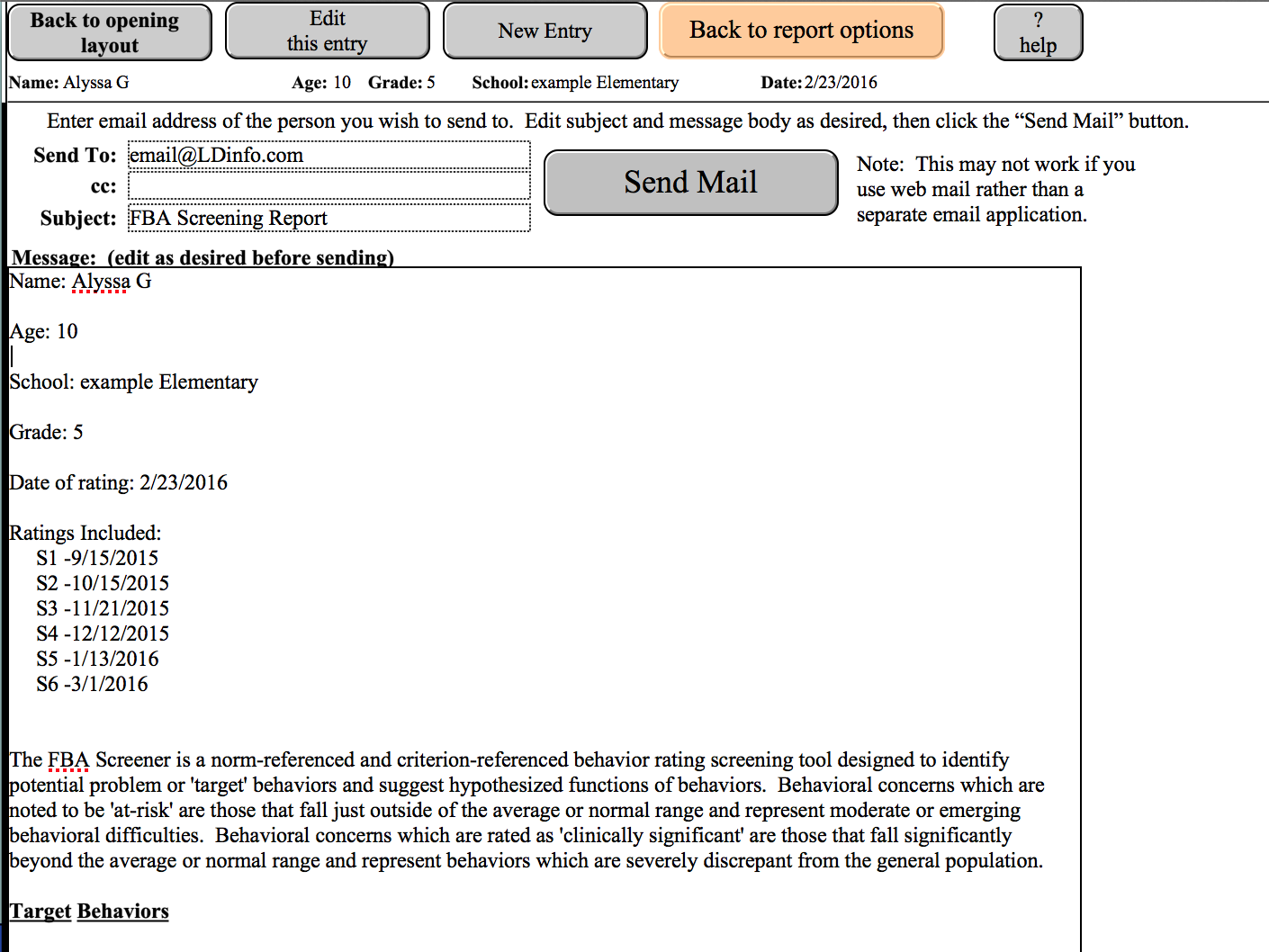
After clicking the "Send Mail" button your email application should open showing a draft of the email.
If the draft does not appear formatted correctly (as below),
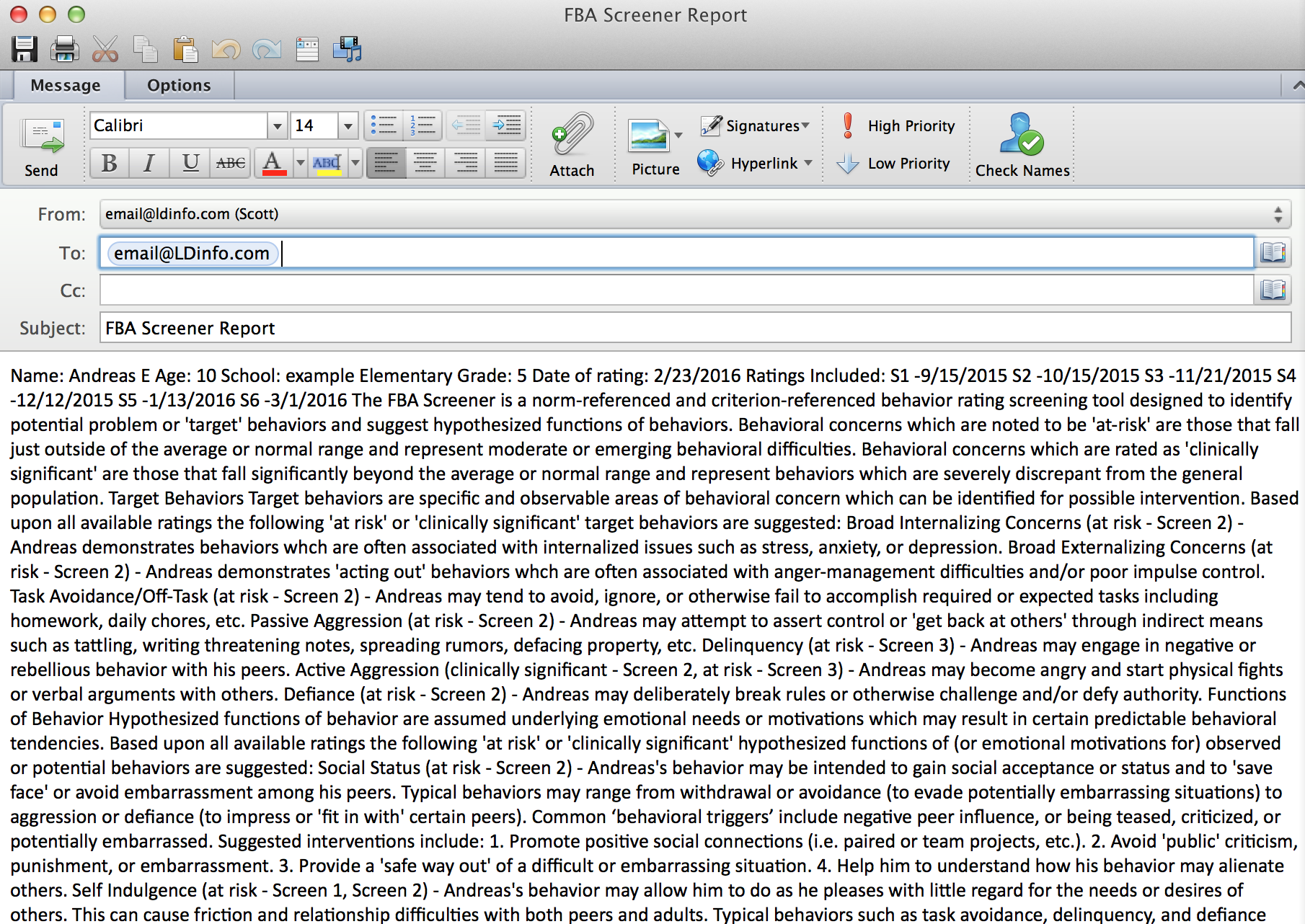
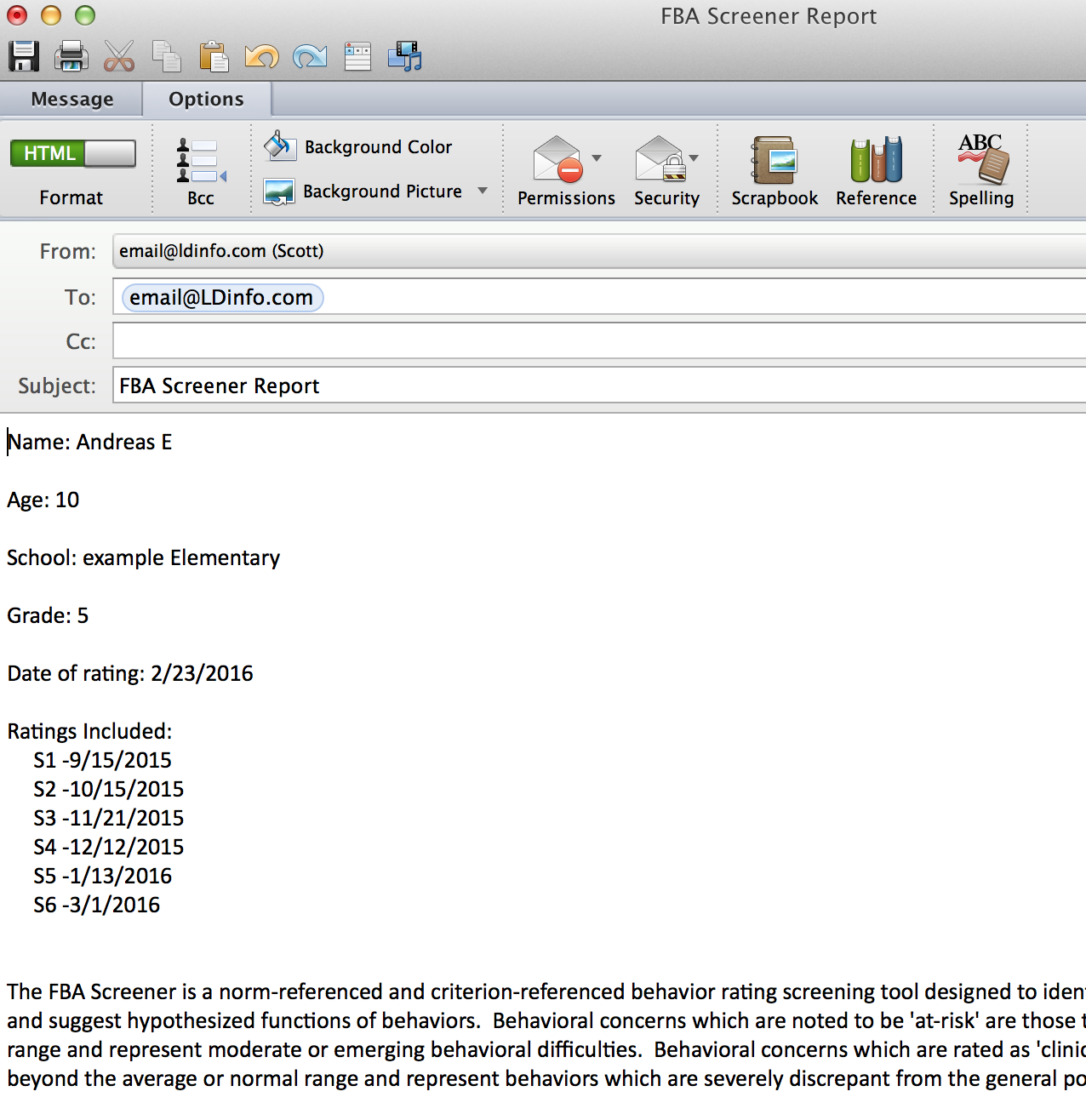
References
Achenbach, T. M., & Rescorla, L. A. (2001).
Manual for the ASEBA school-age forms & profiles. Burlington: University of
Vermont, Research Center for Children, Youth, & Families.
Achenbach, T. M. (1991a). Manual for
the Child Behavior Checklist/4-18 and 1991 Profile. Burlington: University of Vermont, Department of
Psychiatry.
Achenbach, T. M. (1991b). Manual for
Teacher’s Report Form and 1991 Profile. Burlington:
University of Vermont, Department of Psychiatry.
American Psychiatric Association. (2001). Diagnostic
and statistical manual of mental disorders (4th ed., text revision).
Washington, DC: Author.
Individuals With Disabilities Education Act
Amendments of 1997, Pub. L. No. 103-218 (GPO 1997).
Birmaher, B., Khetarpal, S. Brent, D., Cully, M.,
Balach, L., Kaufman, J., & McKenzie, Neer, S. (1997). The
Screen for Child Anxiety Related Emotional Disorders (SCARED): Scale
construction and psychometric characteristics. Journal of the American
Academy of Child and Adolescent Psychiatry, 36, 545-553.
Conners, C. K. (2004) Conners’ Rating
Scales – Revised. Canada:
Multi-Health Systems.
Devereux Foundation. (1999). Devereux
Early Childhood Assessment (DECA). Lewisville, NC: Kaplan Press.
Duman, J.E. & LaFreniere, P.J. (2003). Social
Competence and Behavior Evaluation Preschool Edition (SCBE). Los Angeles, California: Western
Psychological Services.
Gadow, K. D., & Sprafkin, J. (1994). Child
Symptom Inventories manual. Stony
Brook, NY: Checkmate Plus.
Gehring, T. M. (1998). The Family System
Test (FAST). Seattle, WA:
Hogrefe & Huber.
Gresham, F. M., & Elliott, S. N. (1990). Social
Skills Rating System. Circle Pines,
MN: American Guidance.
Grotevant, H. D., & Carlson, C. I.
(1989). Family assessment: A guide to methods and measures. New York: Guilford Press.
Krug, D. A., Arick, J. A., & Almond, P. J.
(1993). Autism Screening Instrument for Educational Planning. Austin, TX: Pro-Ed.
Levick, M. F. (2000). The Levick Emotional
and Cognitive Art Therapy Assessment (LECATA; rev. ed). Boca Raton, FL: South Florida Art
Psychotherapy Institute.
March, J. (1998). Manual for the Multidimensional
Anxiety Scale for Children (MASC). Toronto:
Multi-Health Systems.
Martin, R. P., Hooper, S., & Snow, J.
(1986). Behavior rating scale approaches to personality assessment in
children and adolescents. In H. M. Knoff (Ed.), The psychological
assessment of children and adolescents (pp. 309-351). New York: Guilford Press.
Mitrushina, M. N., Boone, K. B., & D’Elia, L.
F. (1999). Handbook of normative data for neuropsychological
assessment. New York: Oxford
University Press.
Myles, B. S., Bock, S. J., & Simpson, R. L.
(2001). Asperger Syndrome Diagnostic Scale. Austin, TX: Pro-Ed.
Naglieri, J. A., LeBuffe, P. A., & Pfeiffer, S.
I. (1994). Devereux scales of mental disorder. San Antonio, TX: Psychological
Corporation.
Naglieri, J. A., McNeish, T. J., & Bardos, A. N.
(1991). Draw A Person: Screening Procedure for Emotional
Disturbance. (DAP:SPED). Austin, TX:
PRO-ED.
Neisworth, J. T., Bagnato, S. J., Salvia, J., &
Hunt, F. M. (1999). Temperament and Atypical Behavior Scale: Early
Childhood Indicators of Developmental Dysfunction. Baltimore, MD: Paul H. Brookes Publishing Co.
Paunonen, S. V., & Jackson, D. N.
(1998). Nonverbal Personality Questionnaire (NPQ). Port Huron, MI: Sigma Assessment
Systems.
Reynolds, C. R., & Kamphaus, R. W. (2004). BASC-2
Behavior Assessment System for Children, second edition manual. Circle Pines,
MN: American Guidance Service.
Sheridan, S. M., Kratochwill, T. R., & Bergan, J.
R. (1996). Conjoint behavioral consultation: A procedural
manual. New York: Plenum Press.
Silverman, W. K., & Albano, A. M. (1996). The
Anxiety Disorders Interview Schedule for DSM-IV: Child and parent
versions. San Antonio, TX:
Psychological Corporation.
U.S. Bureau of the Census. (2001). Current population
survey, March 2001 [Data file]. Washington, DC: U.S. Department of Commerce.
Special Offer - Get the complete LDinfo Apps software package free for one full year
-
Try the free on-line FBA Profiler - parents rate your children, students rate yourselves, teachers rate your students